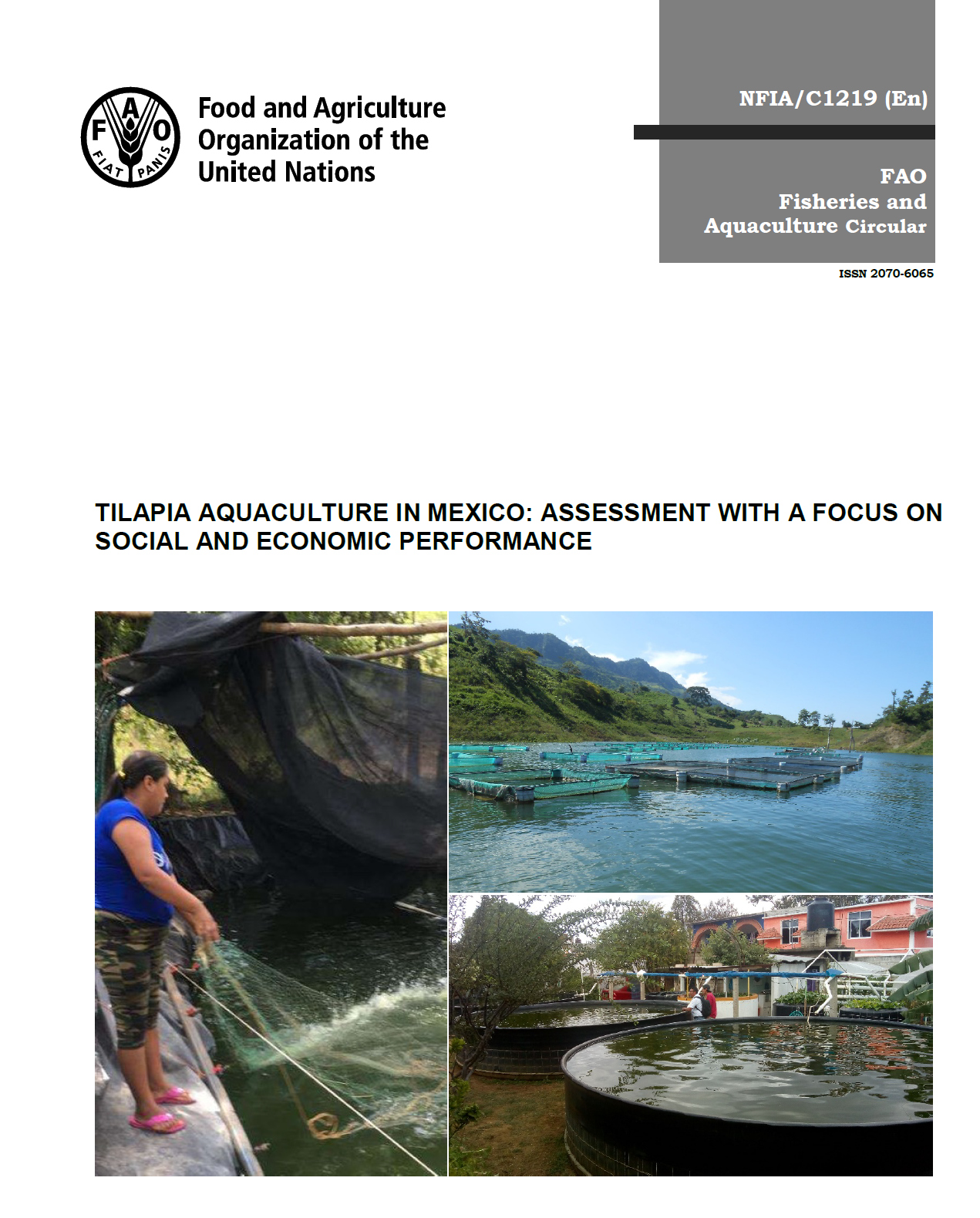
Tilapia Aquaculture in Mexico: Assessment with a Focus on Social and Economic Performance
Authors: Francisco Javier MartÃnez-Cordero, Soledad Delgadillo Tiburcio, Edgar Sanchez-Zazueta and Junning Cai.
Publisher: FAO, Rome, 2021
Tilapia is the second-largest species group in Mexico’s aquaculture with its 53,000 tonnes of production contributing to around 20% of the 247,000 tonnes of total aquaculture production in 2018. One key driving force behind the surge in farmed tilapia production was the big investment in cage tilapia farming by a large commercial farm (i.e. Regal Springs Acuagranjas Dos Lagos SA de CV). The collapse of shrimp farming because of disease outbreaks in the early 2010s also motivated shrimp farmers to farm the tilapia as an alternative species. Tilapia is also farmed to improve water quality and enhance the resistance of shrimp against viral diseases since there is the beneficial effect of polyculture. According to the national statistics, aquaculture accounted for only 31% of Mexico’s total tilapia production in 2018.
Mexico is the second-largest international market for tilapia products, and the 228,000 tonnes live weight equivalent of its tilapia imports in 2018 was higher than its domestic production. Mexico was the second-largest tilapia importer, after the US, accounting for 16% of the world tilapia imports tonnage and 13% of its value in 2018. Nearly all of Mexico’s tilapia imports came from China. Imports composed of frozen tilapia fillets (92%) and frozen whole tilapia (8%) in 2018. There is also a discussion on the declining import prices in Mexico; average prices dropped to USD2.3kg in 2018 from USD3.2/kg in 2013.
The report shows the trend in tilapia consumption in Mexico. The average per capita apparent tilapia consumption in Mexico was 3.08kg (around one fifth of its total fish consumption) in 2018, which was much higher than the 0.9kg world average. There is an extensive coverage on the tilapia value chain in tilapia producing states in Mexico. At the national level, information supplied by Mexican’s Government’s FIRA, showed 2,371 registered tilapia farms, including 10 large-scale enterprises, 400 small and medium-scale farms, and 1,961 subsistence farms. These were supported by 29 public and private hatcheries, 15 feedmills and 225 processing/freezing plants. Others in the tilapia value chain include equipment, machinery, research institutes, certification companies, banks and other financial institutes and marketing channels.
Technical aspects of tilapia farming in Mexico are covered in a chapter where the information is based on field experiences and consultations of many studies and scientific papers. In Mexico, tilapia is farmed in earthen ponds and in pond raceways, floating cages and tanks (concrete circular/ geomembrane circular). Cage culture is the major aquaculture system contributing to production; five major tilapia cage culture operations have a total of around 36,000 tonnes of annual production capacity. However, cage tilapia farming operation requires a permit for water concession and is granted when the operation is considered sustainable and with no negative environmental impacts.
The operational costs for tilapia farming in these various culture systems are covered in detail. Feed is the largest cost item at 72.4% and feed conversion ratio (FCR) of cage farms versus earthen ponds were compared. Other costs items are seed (average 15%) and energy (average 11%).
In general, this document assesses tilapia farming and the value chain in Mexico by examining tilapia farming systems and practices, dissecting the tilapia value chain, evaluating the sector’s social and economic performance, discussing the impacts of proper governance and institutions on the sector development, and highlighting potentials, issues, constraints and challenges in the development of tilapia farming or aquaculture in general. It also looks at the growth potential of tilapia farming in Mexico from a demand perspective. The document ends with a brief discussion of the impact of the ongoing coronavirus (COVID-19) pandemic on the tilapia industry in the country.
MartÃnez-Cordero, F.J., Delgadillo, T.S., Sanchez-Zazueta, E. & Cai, J. 2021. Tilapia aquaculture in Mexico: assessment with a focus on social and economic performance. FAO Fisheries and Aquaculture Circular No. 1219. Rome, FAO. https://doi.org/10.4060/cb3290en




